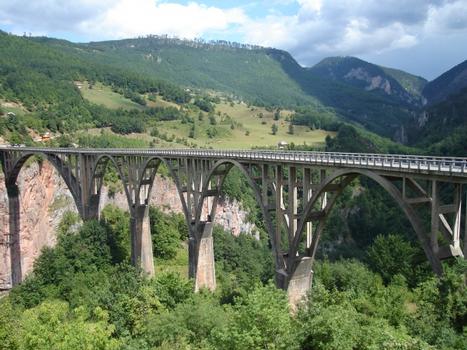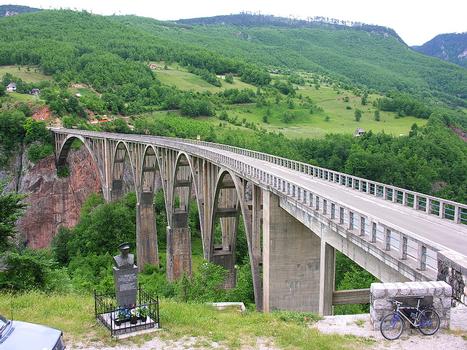General Information
Project Type
| Structure: |
Deck arch bridge |
|---|---|
| Function / usage: |
Road bridge |
| Material: |
Reinforced concrete bridge Structurae Plus/Pro - Subscribe Now! |
Location
| Location: |
Žabljak, Montenegro |
|---|---|
| Crosses: |
|
| Coordinates: | 43° 9' 1.42" N 19° 17' 43.15" E |
Technical Information
Dimensions
| main span | 116 m | |
| height above valley floor or water | 150 m | |
| number of arches | 5 |
Materials
| deck |
reinforced concrete
|
|---|---|
| piers |
reinforced concrete
|
| arches |
reinforced concrete
|
| abutments |
reinforced concrete
|
| piers on arch |
reinforced concrete
|
Excerpt from Wikipedia
Đurđevića Tara Bridge (pronounced [dʑǔːrdʑɛv̞iːtɕaː târa]) is a concrete arch bridge over the Tara River in northern Montenegro. It is located at the crossroads between Mojkovac, Žabljak and Pljevlja, between the villages of Budečevica and Trešnjica.
Construction
Đurđevića Tara Bridge, which was designed by Mijat Trojanović, was built between 1937 and 1940 in the Kingdom of Yugoslavia. The project's Chief Engineer was Isaac Russo.
The 365-metre-long (1,198 ft) bridge has five arches; the largest span is 116 metres (381 ft). The roadway stands 172 metres (564 ft) above the Tara River. At the time of its completion, it was the biggest vehicular concrete arch bridge in Europe.
World War II
Much of Montenegro, including the Tara Canyon, came under Italian occupation following the German-led invasion of Yugoslavia in April 1941. As the mountainous terrain made it suitable for guerrilla warfare, a partisan uprising occurred in the area. Italian forces took control of the Tara Bridge during an Italian offensive in 1942.
A Yugoslav Partisan raiding party blew up the central arch with the aid of one of the bridge engineers, Lazar Jauković. The attack cut the only feasible crossing over the Tara Canyon halting the Italian advance. When Jauković was eventually captured, however, the Italians executed the engineer.
These events were depicted in the 1969 Yugoslav film Most.
Present day
The bridge was rebuilt in 1946. It was used in the 1978 British action film Force 10 from Navarone set during World War II. Bungee jumping is organised on the longest arch directly above Tara river.
The bridge also plays a large part in the Dutch novel 'Het land achter Gods rug' by A. den Doolaard, which was published in 1956. This novel is partly based on the true story of the bridge including its destruction by partisans during the World War II.
Text imported from Wikipedia article "%C4%90ur%C4%91evi%C4%87a Tara Bridge" and modified on July 23, 2019 according to the CC-BY-SA 4.0 International license.
Participants
Relevant Web Sites
Relevant Publications
- (1941): Vom Bau der Strassenbrücke über die Tara in Jugoslavien. In: Schweizerische Bauzeitung (1883-1946), v. 118, n. 22 (29 November 1941), pp. 260-261.
- About this
data sheet - Structure-ID
20025881 - Published on:
12/01/2007 - Last updated on:
02/11/2017








